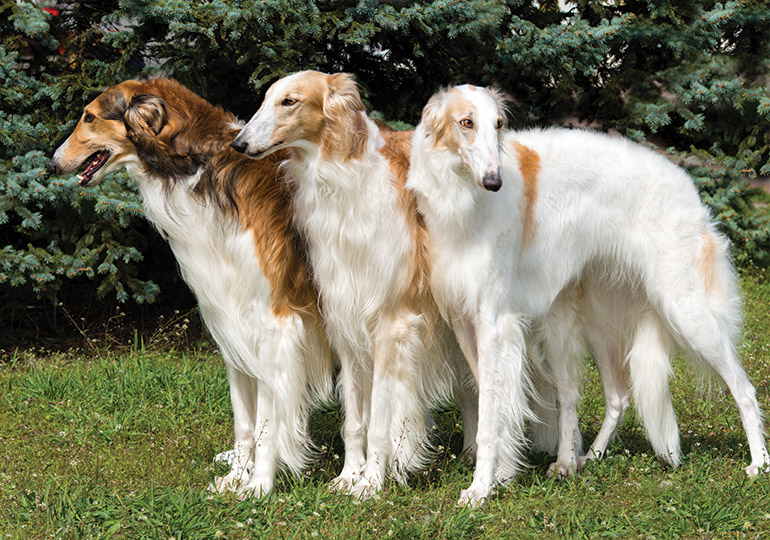Borzoi
Breed Details
Size:
Exercise Requirements:
Grooming Requirements:
25-48 kg (approx)
10-12 years (approx)

Appearance
The borzoi is best described as a large greyhound robed in a long, silky coat. Like a typical greyhound, it has family traits of long, slender legs, relatively narrow body, deep chest, tucked abdomen, arched loin and long tail. His head is extraordinarily long and narrow. The borzoi's grace is evident in his every move.
Although smaller than an Irish wolfhound, borzoi are still very large, and especially tall, dogs. The males are at least 28 inches tall, and females at least 26 inches. Realistically, these would be considered very small borzoi. Today most males are probably 32 to 34 inches tall, with the females somewhat smaller. They are narrow, though, so that they weigh less than other dogs of comparable height.
History
To catch the Russian wolf, a dog would have to be fleet-like a greyhound. But this greyhound would have to be covered with a thick coat to brave the frigid winds, a coat that was probably infused from a type of Russian sheepdog. And he would have to be strong and courageous, traits gained from crosses to Russian bear hounds. To capture the hearts of the Russian aristocracy, the dog would have to be beautiful — and the borzoi's beauty is not borrowed from any other breed.
The breed was in its formative stages in the Middle Ages; in the 16th century the first breed standard was presented. A borzoi hunt was among the grandest hunting events ever staged, the hunting party often arriving in a huge trainload of dogs, horses, serfs and nobility. Two or three matched borzoi were unleashed on a wolf that had been flushed into the open; the borzoi had to sprint to catch it before it reached cover on the other side of the field. Their job was to hold the wolf until the huntsman came to bind it. The Russian aristocracy kept grandiose kennels of hundreds of borzoi. Most of these dogs were killed as hated symbols of the Russian rulers after the Russian Revolution. The borzoi of today descends from a few that escaped death as well as the descendants of dogs that had been given as gifts to foreign dignitaries.
Temperament
Borzoi know they are aristocrats, but they also hide a bit of court jester. They are good-natured, gentle and calm, seemingly amused at whatever entertainment comes their way. They are happiest when that entertainment involves running. True to their heritage, borzoi are avid hunters, and will chase any small fleeing animal. They cannot be called off the chase, and they are oblivious to cars. Obedience lessons are apt to be met with a sense of humour, but borzoi will humour you and do some semblance of what you ask them.
Care/Grooming
To brush a Borzoi, use long strokes and go all the way to the skin. In heavily coated areas you may need brush the coat out in layers. I brush in the direction the coat lies. Pin brushes keep damage to the coat down to a minimum.

